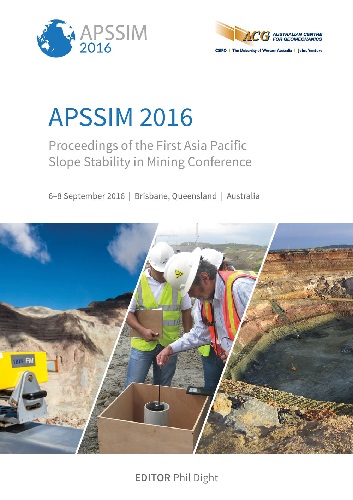Operational mine monitoring with InSAR

|
Authors: Taylor, K; Ghuman, P; McCardle, A |
DOI https://doi.org/10.36487/ACG_rep/1604_48_Taylor
Cite As:
Taylor, K, Ghuman, P & McCardle, A 2016, 'Operational mine monitoring with InSAR', in PM Dight (ed.), APSSIM 2016: Proceedings of the First Asia Pacific Slope Stability in Mining Conference, Australian Centre for Geomechanics, Perth, pp. 695-706, https://doi.org/10.36487/ACG_rep/1604_48_Taylor
Abstract:
Imagery acquired from spaceborne Synthetic Aperture Radar (SAR) sensors can be used to monitor ground motion over man-made targets and natural terrain. SAR Interferometry (InSAR) has been demonstrated as an effective tool for characterising slope creep and subsidence at operating mine sites. Conventional InSAR approaches are limited in their ability to monitor areas of active dumping/excavation and measure fast motion. Furthermore, there is typically a latency of weeks to months between occurrence of movement and delivery of monitoring products to mine engineers. Operational improvements to InSAR processing and onsite product usage have shifted InSAR from a nice-to-have to a need-to-have service at many mines. This paper examines three case studies of InSAR use for operational mining. In the first, motion detected over 12 months at an open pit mine is reviewed. In this pit, the ground-based monitoring is extensive and can be used to verify areas of motion that are at the high end of InSAR's detectable range of motion. Other in situ instrumentation can detect sub-millimetre deformation; however, they are single point measurements rather than the wide coverage offered by InSAR. InSAR’s wide coverage is shown to detect previously unknown areas of movement. The second case study is from an underground mine using the block-caving mining method. The InSAR images cover the entire area of surface subsidence. InSAR measurements are used to determine the limits of deformation as a result of caving, to a level of 1 mm over one year. In the field, this measurement of small deformation extends beyond the visible crack limit. By comparing InSAR deformation over several years, the changing limits of the block caving strain front can be mapped and compared to crack limit predictions, existing cracks that have been mapped in the field, and historic production limits to improve the predictions of deformation and caving advance into the future. The third case study is from a run-of-mine stockpile located at an open pit mining facility. InSAR measurements are used to measure deformation over the entire surface of the stockpile. In this case, the deformation is caused by settlement, rather than instability. The data is evaluated to distinguish settlement from instability. Unfortunately, there are few available cases of instability monitored with InSAR with which to compare to normal settlement. Distinctions are suggested, to be validated with future work. Evaluating the results of InSAR monitoring allows for improved risk management of geotechnical hazards because previously unknown areas of motion, or unrealised extent of existing areas, can be identified when the rate of motion is very small. The additional time provided by this early warning can give a mine operator valuable time to re-assess the hazards, and undertake more thorough analysis or install more focused monitoring in order to mitigate the risk, if necessary. Additionally, the improved knowledge of the state of stability of the geotechnical structure allows for improved analysis and design, which can result in more optimised design and operation of the mine.
Keywords: mine, monitoring, deformation, motion, InSAR
References:
Goldstein, RM & Werner, CL 1998, ‘Radar Interferogram Filtering for Geophysical Applications’, Geophysical Research Letters, vol. 25, no. 21, pp. 4035–4038.
Herrera, G, Tomás, R, Vicente, F, Lopez-Sanchez, J, Mallorqui, J & Mulas, J 2010, ‘Mapping ground movements in open pit mining areas using differential SAR interferometry’, International Journal of Rock Mechanics and Mining Sciences, Elsevier, vol. 47, pp. 1114–1125.
Rabus, B, Ghuman, P, Nadeau, C, Eberhardt, E, Stead, D, Woo, K, Severin, J, Styles, T & Gao, F 2009, ‘Application of InSAR to constrain 3-D numerical modelling of complex discontinuous pit slope deformations’, Slope Stability Symposium, Chile, p. 15.
© Copyright 2025, Australian Centre for Geomechanics (ACG), The University of Western Australia. All rights reserved.
View copyright/legal information
Please direct any queries or error reports to repository-acg@uwa.edu.au
View copyright/legal information
Please direct any queries or error reports to repository-acg@uwa.edu.au